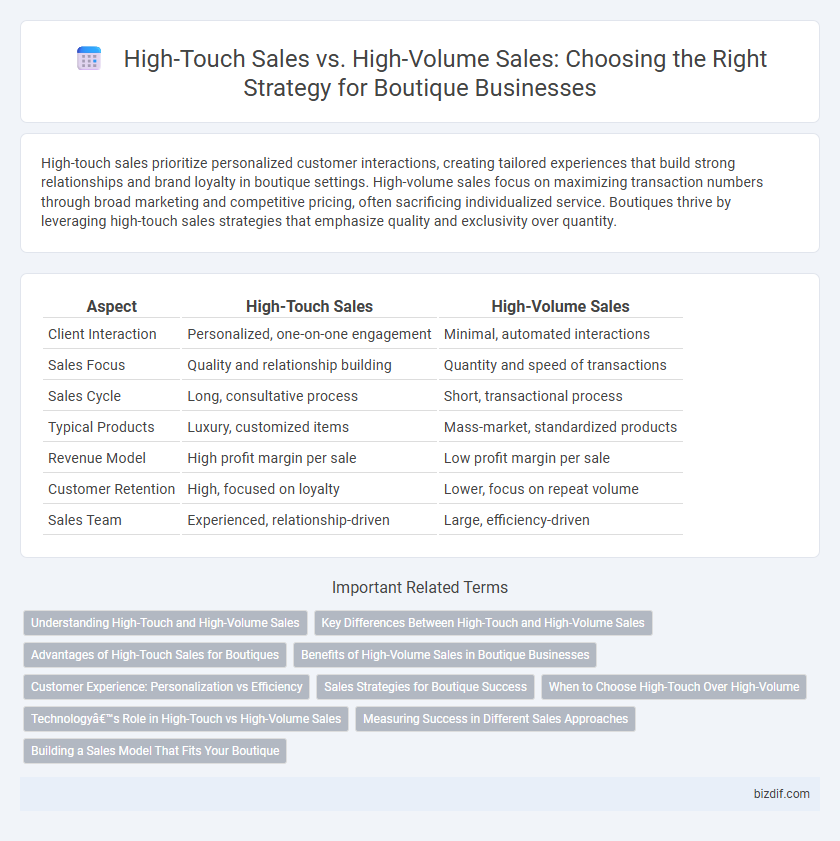High-touch sales prioritize personalized customer interactions, creating tailored experiences that build strong relationships and brand loyalty in boutique settings. High-volume sales focus on maximizing transaction numbers through broad marketing and competitive pricing, often sacrificing individualized service. Boutiques thrive by leveraging high-touch sales strategies that emphasize quality and exclusivity over quantity.
Table of Comparison
| Aspect | High-Touch Sales | High-Volume Sales |
|---|---|---|
| Client Interaction | Personalized, one-on-one engagement | Minimal, automated interactions |
| Sales Focus | Quality and relationship building | Quantity and speed of transactions |
| Sales Cycle | Long, consultative process | Short, transactional process |
| Typical Products | Luxury, customized items | Mass-market, standardized products |
| Revenue Model | High profit margin per sale | Low profit margin per sale |
| Customer Retention | High, focused on loyalty | Lower, focus on repeat volume |
| Sales Team | Experienced, relationship-driven | Large, efficiency-driven |
Understanding High-Touch and High-Volume Sales
High-touch sales emphasize personalized customer interactions and relationship-building, often involving detailed consultations and tailored solutions to meet individual client needs, ideal for luxury boutiques seeking exclusivity. High-volume sales prioritize rapid transactions and broad customer reach, focusing on standardized products and efficient processes to maximize sales quantity. Understanding these sales approaches helps boutiques balance exclusivity with scalability to optimize revenue and customer satisfaction.
Key Differences Between High-Touch and High-Volume Sales
High-touch sales emphasize personalized interactions, tailored customer experiences, and longer sales cycles targeting niche markets, often involving luxury or high-value products. High-volume sales prioritize rapid transactions, standardized processes, and mass-market reach, aiming to maximize unit sales and revenue through efficiency. Key differences include the level of customer engagement, sales cycle duration, and product complexity, with high-touch leveraging relationship-building and high-volume focusing on scalability.
Advantages of High-Touch Sales for Boutiques
High-touch sales in boutiques prioritize personalized customer experiences, fostering strong relationships that drive loyalty and repeat business. This approach allows sales associates to tailor product recommendations, enhancing customer satisfaction and perceived value. Boutiques benefit from higher profit margins and brand differentiation by focusing on quality interactions over mere transaction volume.
Benefits of High-Volume Sales in Boutique Businesses
High-volume sales in boutique businesses drive consistent revenue streams by attracting a broad customer base through affordable pricing and diverse product offerings. This strategy enhances brand visibility and market presence, enabling economies of scale that reduce costs and increase profit margins. By leveraging data analytics, boutiques can optimize inventory management and marketing efforts, maximizing sales efficiency and customer satisfaction.
Customer Experience: Personalization vs Efficiency
High-Touch Sales prioritize personalized customer experience through tailored interactions and customized recommendations, fostering strong relationships and brand loyalty in boutiques. High-Volume Sales emphasize efficiency, streamlining transactions to serve a larger number of customers quickly, often leveraging technology for rapid processing. Boutiques focusing on High-Touch Sales enhance customer satisfaction by delivering unique, memorable shopping experiences that differentiate them from mass-market competitors.
Sales Strategies for Boutique Success
High-touch sales emphasize personalized customer interactions and tailored experiences, crucial for boutiques aiming to build strong client relationships and brand loyalty. High-volume sales prioritize rapid transactions and broad customer reach, often less effective for boutique businesses seeking exclusivity and premium service. Combining targeted high-touch strategies with selective volume tactics can optimize boutique success by balancing bespoke service with sustainable sales growth.
When to Choose High-Touch Over High-Volume
High-touch sales are ideal for boutique businesses offering personalized, luxury, or custom products where customer experience and relationship-building drive revenue. Choosing high-touch sales over high-volume sales makes sense when targeting niche markets that demand tailored solutions and higher customer engagement. This approach maximizes customer lifetime value and brand loyalty in markets less sensitive to price competition.
Technology’s Role in High-Touch vs High-Volume Sales
Technology in high-touch sales leverages CRM systems and AI-driven personal analytics to enhance client relationships and tailor bespoke experiences, driving deeper customer engagement. In contrast, high-volume sales use automation tools, e-commerce platforms, and predictive analytics to optimize transaction efficiency and scale outreach rapidly. Integrating advanced technology in boutiques enables seamless management of both personalized service and broad market reach, balancing customer intimacy with sales volume growth.
Measuring Success in Different Sales Approaches
High-touch sales emphasize personalized customer interactions, where success is measured by customer satisfaction, retention rate, and lifetime value. In contrast, high-volume sales focus on transactional efficiency, prioritizing metrics such as conversion rate, sales volume, and average order value. Boutique businesses typically excel in high-touch sales by leveraging deep customer relationships and tailored experiences to drive long-term growth.
Building a Sales Model That Fits Your Boutique
Creating a sales model tailored to your boutique requires balancing high-touch sales, which emphasize personalized customer experiences and relationship building, with high-volume sales that focus on efficiency and a larger customer base. High-touch sales strategies drive customer loyalty and higher average transaction values, ideal for luxury or niche boutiques, while high-volume sales optimize operations for faster turnover and broader market reach. Analyzing customer behavior and product type helps determine the optimal mix, ensuring sustainable growth and a distinctive boutique brand identity.
High-Touch Sales vs High-Volume Sales Infographic

 bizdif.com
bizdif.com